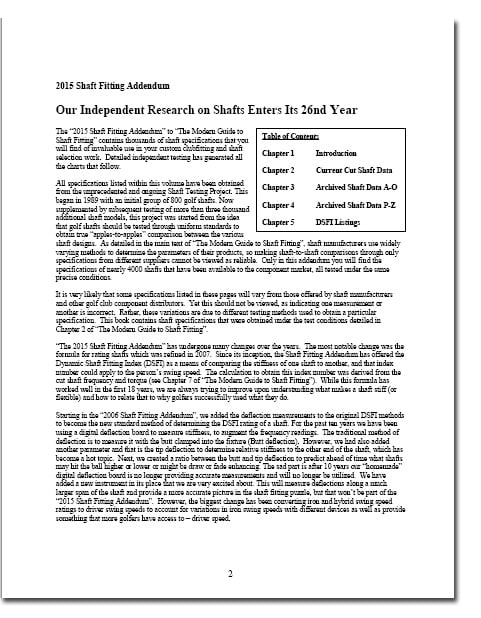What Is The Best Golf Shaft For My Game?
The Dynamic Shaft Fitting Index was created as a way to help you sort through the confusion of choosing the perfect shaft for your game.
 One comment I often hear from customers who are aging assume that by going to a more flexible shaft will gain them some extra distance. I want to take time to dispel what could be a myth and at least give all the facts so one can make an intelligent buying decision the next time you (or one of your customers) are in need of a new club or re-shafting an existing one.
One comment I often hear from customers who are aging assume that by going to a more flexible shaft will gain them some extra distance. I want to take time to dispel what could be a myth and at least give all the facts so one can make an intelligent buying decision the next time you (or one of your customers) are in need of a new club or re-shafting an existing one.
First of all, distance is a function of many things including speed, loft, direction and solidness of contact. Let’s look at the first one – speed. The components for speed are how long a club is made, how much it weighs and weight distribution. Granted, the A-flex shaft in a particular pattern of shaft is generally a little lighter than the R-flex, but it may only be a gram or two and that is spread over the entire length of the shafts. It may take in the magnitude of 7-10 gram minimal to be even felt. So that in itself would not contribute to an increase of speed or distance. Plus club length is independent from the flex.
Loft is also a major key contributor to distance. If you hit the ball too high or too low, both can rob you of distance. There is an optimal launch angle that will give you the most overall distance (carry + roll). Here is one possibility that additional flex can help increase distance. By opting for a more flexible shaft, that can change the dynamics of the club as it comes into impact. Generally a more flexible shaft will bend more forward at impact than the stiffer flex (in the same model) thus increasing the loft and providing a slightly higher ball flight. We aren’t talking about a large change, but only a small one. However, if you are one to hit the ball low compared to your playing partners, going more flexible could help optimize launch angle.
There is a caveat to that though. You still need to maintain the solidness of contact at impact. With some golfers who have an abbreviated swing or quick tempo, going more flexible (even though their swing speed is declining) may make it more difficult to square the face at impact. If you were hitting the ball straight before and now dropping down a flex you begin to hit more of a high fade because you can’t time it like you were, that could rob one of distance too. Let’s look at the other side of that argument. It is very possible one could be hitting a high fade because the shaft is too stiff for their needs and inhibiting the face from closing and squaring up at impact. In this case, the more flexible shaft could position the face in a manner to optimize loft and direction that is could result into more distance.
So there you have it, going to a more flexible shaft as you age could help or hinder your search for more distance depending upon your circumstances. The most important part is to get fit by a professional clubmaker or experiment with different shafts. Here is another point to chew on. Going from R to A-flex in the same brand and make of shaft is one thing, but if you start changing brand names and models then that opens up another can o’ worms because there is no standardization for shaft flex in the industry. Even if you drop down a flex in the exact same weight shaft, but in another model, there is a chance you might be selecting a stiffer shaft and defeating the purpose or possibly getting a shaft that is now too flexible and going from one extreme to another.
This is why we created the Dynamic Shaft Fitting Index as a way to help sort through the confusion. For those that have used this valuable resource in the past, we have an updated version. For those who want to be educated on shafts, then here is your opportunity to explore the world of shafts and shaft fitting.
